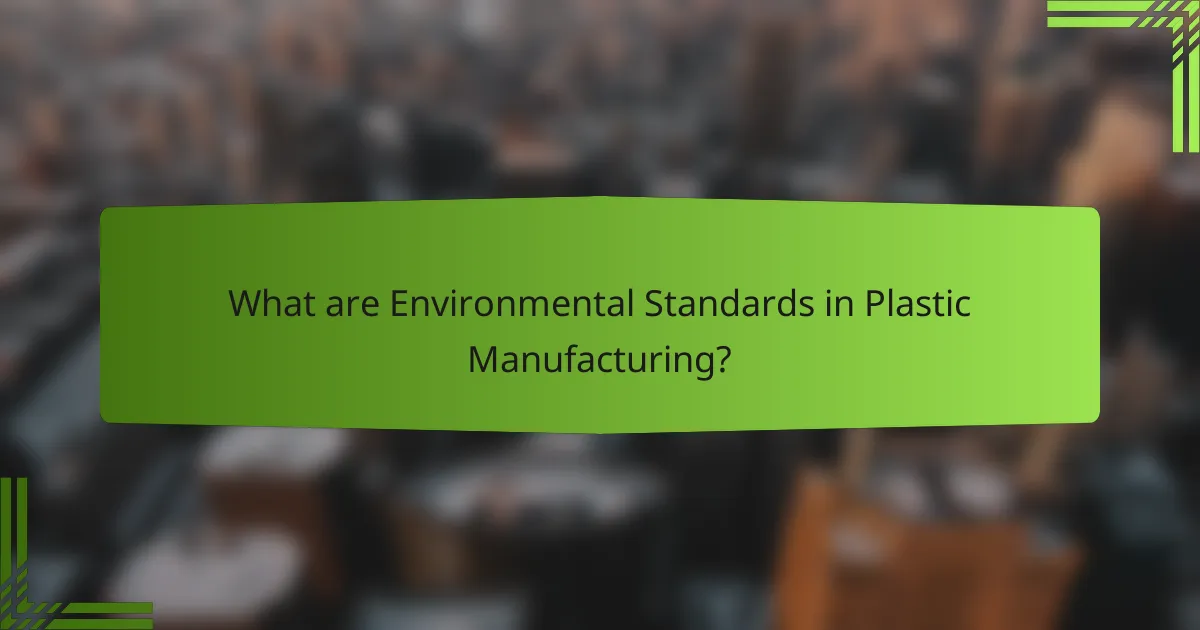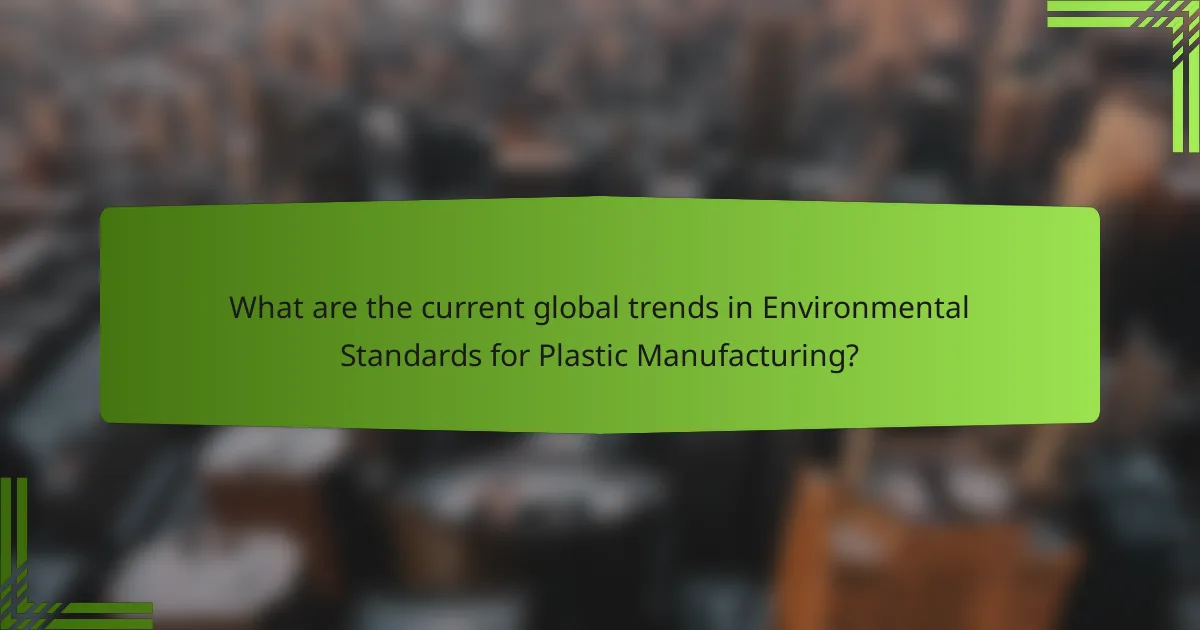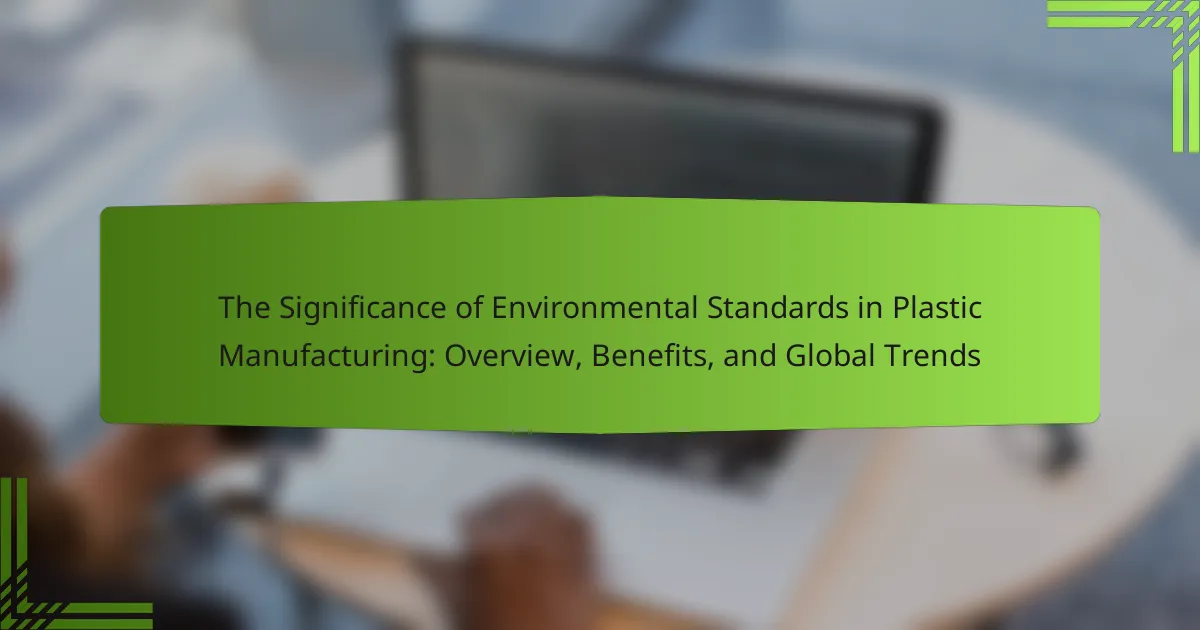Environmental standards in plastic manufacturing are regulations designed to limit the environmental impact of plastic production, focusing on aspects such as emissions, waste management, and resource usage. These standards, including ISO 14001 and the European Union’s REACH regulation, aim to reduce pollution, promote sustainability, and enhance public health by encouraging companies to adopt eco-friendly practices. Compliance with these regulations not only improves operational efficiency and reduces costs but also bolsters market reputation among environmentally conscious consumers. Current global trends highlight an increase in regulatory measures, a shift towards sustainable materials, and the adoption of circular economy models in the plastic industry, reflecting a growing commitment to environmental protection.

What are Environmental Standards in Plastic Manufacturing?
Environmental standards in plastic manufacturing are regulations that set limits on the environmental impact of plastic production. These standards aim to reduce pollution and promote sustainable practices. They often cover aspects like emissions, waste management, and resource usage. For instance, the ISO 14001 standard focuses on effective environmental management systems. Compliance with these standards is essential for manufacturers to minimize their ecological footprint. Many countries have established specific regulations, such as the European Union’s REACH regulation, which governs chemical safety in plastics. Adhering to these standards can lead to improved public health and environmental protection.
How do these standards impact the plastic manufacturing process?
Environmental standards significantly impact the plastic manufacturing process by enforcing regulations that promote sustainability. These standards require manufacturers to adopt eco-friendly practices. Compliance often leads to the reduction of harmful emissions during production. Additionally, they encourage the use of recyclable materials in the manufacturing process. Companies may also need to invest in cleaner technologies to meet these standards. This shift can enhance operational efficiency and reduce waste. Ultimately, adherence to environmental standards can improve a company’s marketability and consumer trust. Research shows that companies following these standards experience better long-term profitability.
What specific regulations are included in environmental standards?
Environmental standards include regulations that govern air quality, water quality, waste management, and chemical safety. These regulations ensure compliance with limits on emissions and discharges. For example, the Clean Air Act sets limits on air pollutants. The Clean Water Act regulates discharges into water bodies. The Resource Conservation and Recovery Act oversees hazardous waste management. Additionally, the Toxic Substances Control Act manages the use of chemicals. These regulations are essential for protecting public health and the environment. They provide a framework for sustainability in industries, including plastic manufacturing.
How do these regulations vary across different regions?
Environmental regulations in plastic manufacturing vary significantly across different regions. In Europe, strict regulations such as the EU Plastics Strategy promote sustainable practices. The European Union emphasizes reducing plastic waste and enhancing recyclability. In contrast, the United States has a more fragmented regulatory approach. Regulations vary by state, with some states implementing stringent measures while others have minimal requirements. In Asia, countries like Japan have advanced recycling laws, while others may lack comprehensive regulations. These regional differences influence manufacturing practices, compliance costs, and environmental impact.
Why are Environmental Standards significant in the industry?
Environmental standards are significant in the industry because they ensure compliance with regulations that protect the environment. These standards help reduce pollution and minimize waste in manufacturing processes. They promote sustainable practices that can lead to resource conservation. Companies adhering to these standards often gain a competitive advantage. For instance, they may benefit from improved public perception and customer loyalty. According to the Global Reporting Initiative, organizations that implement environmental standards see a 20% reduction in operational costs. This demonstrates the financial benefits alongside environmental protection. Overall, environmental standards are crucial for fostering responsible industrial practices.
What role do they play in sustainability efforts?
Environmental standards in plastic manufacturing play a crucial role in sustainability efforts. They guide manufacturers to reduce waste and emissions. These standards promote the use of recyclable materials. They also encourage energy efficiency in production processes. Compliance with environmental standards can lead to lower carbon footprints. For example, companies adhering to ISO 14001 have reported significant reductions in environmental impact. Furthermore, these standards help in fostering innovation in sustainable materials. They create accountability and transparency in the industry. Overall, environmental standards are essential for driving sustainable practices in plastic manufacturing.
How do they influence consumer perceptions and behaviors?
Environmental standards in plastic manufacturing influence consumer perceptions and behaviors by promoting sustainability and ethical practices. Consumers increasingly prefer products that align with their values regarding environmental protection. Research indicates that 73% of millennials are willing to pay more for sustainable products. This trend shapes purchasing decisions and creates brand loyalty among environmentally conscious consumers. Additionally, transparent communication about environmental standards fosters trust and enhances brand reputation. Brands that adhere to these standards often see increased sales and market share as consumers gravitate towards responsible choices.

What are the benefits of implementing Environmental Standards?
Implementing environmental standards leads to reduced pollution and improved public health. These standards help companies minimize waste and emissions during production. By adhering to environmental regulations, businesses can enhance their operational efficiency. Improved efficiency often results in cost savings over time.
Additionally, environmental standards promote sustainable practices. They encourage the use of renewable resources and energy-efficient technologies. Companies that comply with these standards can improve their market reputation. A positive reputation can attract environmentally conscious consumers.
Research shows that businesses with strong environmental practices can outperform their competitors financially. The Carbon Disclosure Project reported that companies with robust sustainability strategies have lower costs and higher profitability.
How do these standards enhance product quality?
Environmental standards enhance product quality by ensuring consistency and safety in plastic manufacturing. These standards set specific requirements for materials, processes, and final products. Compliance with these regulations minimizes defects and variability in production. It leads to better performance and durability of plastic products. For instance, standards like ISO 9001 emphasize quality management systems. This encourages manufacturers to adopt best practices and continuous improvement. As a result, products meet customer expectations more reliably. Additionally, adherence to environmental standards often leads to the use of sustainable materials. This not only improves quality but also enhances the brand’s reputation.
What are the long-term economic benefits for manufacturers?
Long-term economic benefits for manufacturers include cost savings, increased efficiency, and enhanced market competitiveness. Implementing environmental standards often leads to reduced waste and lower energy consumption. For instance, manufacturers adopting energy-efficient technologies can save up to 30% on energy costs. Improved operational efficiency can also result in higher production rates and lower operational costs. Companies that meet environmental standards often gain access to new markets and customers who prioritize sustainability. A study by McKinsey & Company found that firms with strong sustainability practices can outperform their peers financially. Overall, manufacturers that embrace environmental standards position themselves for long-term profitability and resilience.
How do they contribute to brand reputation?
Environmental standards in plastic manufacturing contribute to brand reputation by enhancing consumer trust and loyalty. Companies adhering to these standards demonstrate a commitment to sustainability. This commitment can lead to positive public perception. Research indicates that 66% of consumers are willing to pay more for sustainable brands. Brands that prioritize environmental standards often experience increased customer satisfaction. Additionally, compliance with regulations can prevent legal issues and enhance operational efficiency. Overall, these factors collectively strengthen the brand’s reputation in the marketplace.
What environmental benefits arise from these standards?
Environmental standards in plastic manufacturing promote sustainability and reduce pollution. These standards limit harmful emissions during production processes. They encourage the use of recycled materials, thereby conserving resources. Compliance with these standards can lead to reduced waste generation. Additionally, they often mandate the use of eco-friendly chemicals. This contributes to improved air and water quality. Studies show that companies adhering to these standards experience lower environmental impact. Overall, these standards play a crucial role in protecting ecosystems.
How do they reduce waste and pollution?
They reduce waste and pollution by implementing recycling processes and using biodegradable materials. Recycling helps to minimize the amount of plastic waste sent to landfills. Biodegradable materials break down more easily in the environment, reducing long-term pollution. Additionally, manufacturers adopt cleaner production techniques that limit emissions. These techniques often involve using less harmful chemicals and optimizing energy use. Studies show that companies following environmental standards can lower their waste output significantly. For example, a report from the Ellen MacArthur Foundation indicates that proper recycling can reduce plastic waste by up to 70%.
What impact do they have on resource conservation?
Environmental standards in plastic manufacturing significantly enhance resource conservation. They promote the efficient use of raw materials. This efficiency reduces waste generation during production processes. Standards often encourage the use of recycled materials. Utilizing recycled content lessens the demand for virgin resources. Furthermore, these standards can lead to energy savings. For instance, energy-efficient manufacturing processes lower fossil fuel consumption. According to a study by the Ellen MacArthur Foundation, adopting circular economy principles can reduce plastic production’s carbon footprint by 45% by 2030. This demonstrates that environmental standards play a crucial role in conserving resources.

What are the current global trends in Environmental Standards for Plastic Manufacturing?
Current global trends in environmental standards for plastic manufacturing include increased regulation and sustainability initiatives. Governments worldwide are implementing stricter regulations to limit plastic waste and emissions. The European Union’s Plastics Strategy aims to make all plastic packaging recyclable by 2030. Many countries are adopting extended producer responsibility (EPR) laws, requiring manufacturers to manage the lifecycle of their products. There is a growing emphasis on biodegradable and compostable plastics as alternatives. Companies are investing in eco-design principles to reduce environmental impact. Additionally, consumer demand for sustainable products is influencing manufacturing practices. The rise of circular economy models promotes recycling and reuse in the plastic industry.
How are international agreements shaping these standards?
International agreements are shaping environmental standards in plastic manufacturing by establishing guidelines for sustainability. These agreements promote best practices among nations, encouraging compliance with environmental regulations. For example, the Paris Agreement sets targets for reducing greenhouse gas emissions, influencing manufacturers to adopt eco-friendly processes. Additionally, the Basel Convention regulates the transboundary movement of hazardous waste, impacting how plastic waste is managed globally. Such frameworks facilitate cooperation among countries, leading to harmonized standards. This alignment helps businesses adapt to international market demands for sustainable products. Overall, international agreements drive innovation and accountability in the plastic manufacturing sector.
What role do organizations play in standardization efforts?
Organizations play a crucial role in standardization efforts by developing and implementing industry standards. They collaborate with stakeholders to identify best practices and establish benchmarks. Organizations facilitate the creation of guidelines that enhance product quality and safety. They also promote compliance with environmental regulations, particularly in plastic manufacturing. For example, the International Organization for Standardization (ISO) creates standards that help reduce environmental impacts. By engaging in standardization, organizations support innovation and foster market competitiveness. Their efforts contribute to harmonizing practices across different regions and industries. This ultimately leads to improved sustainability in manufacturing processes.
What innovations are emerging in response to these standards?
Innovations emerging in response to environmental standards in plastic manufacturing include biodegradable plastics and advanced recycling technologies. Biodegradable plastics are designed to decompose more quickly than traditional plastics. They reduce long-term waste in landfills and oceans. Advanced recycling technologies, such as chemical recycling, convert plastics back into raw materials. This process minimizes waste and allows for the reuse of resources. Furthermore, companies are investing in plant-based materials as alternatives to petroleum-based plastics. These innovations align with stricter regulations aimed at reducing environmental impact. The shift towards sustainable practices is evident in industry reports showing increased adoption of eco-friendly materials.
How are manufacturers adapting to meet evolving regulations?
Manufacturers are adapting to evolving regulations by implementing sustainable practices and technologies. They are investing in eco-friendly materials to reduce environmental impact. Many are enhancing waste management systems to comply with stricter disposal regulations. Manufacturers are also adopting energy-efficient production processes to meet energy consumption standards. Additionally, they are conducting regular audits to ensure compliance with regulatory changes. Training programs for employees on new regulations are becoming common. Collaboration with regulatory bodies is increasing to anticipate future changes. These adaptations help manufacturers remain competitive while meeting legal requirements.
What practical steps can manufacturers take to comply with Environmental Standards?
Manufacturers can comply with Environmental Standards by implementing specific practices. They should conduct regular environmental audits to assess compliance levels. Training employees on environmental regulations is essential for awareness and adherence. Utilizing eco-friendly materials can significantly reduce environmental impact. Manufacturers must also establish waste management systems to minimize waste generation. Implementing energy-efficient technologies can lower carbon emissions. Collaborating with suppliers who adhere to environmental standards is beneficial. Finally, staying updated on regulations ensures ongoing compliance and adaptation.
Environmental standards in plastic manufacturing are regulations designed to limit the environmental impact of plastic production, focusing on pollution reduction and sustainable practices. This article provides an overview of the significance of these standards, detailing their effects on manufacturing processes, compliance requirements, and the benefits for businesses and the environment. It also explores current global trends, regional variations in regulations, and innovations emerging in response to these standards, highlighting the role of organizations and international agreements in shaping sustainability efforts within the industry. The content emphasizes the economic advantages and enhanced brand reputation that come with adherence to environmental standards.


